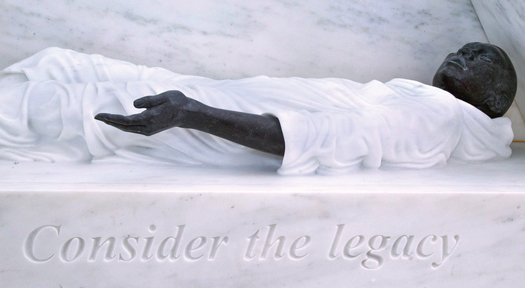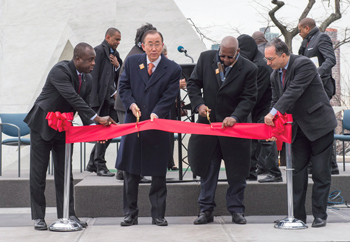UN unveils permanent memorial to victims of Trans-Atlantic Slave Trade
By UN.org | Last updated: Apr 3, 2015 - 11:28:05 AMWhat's your opinion on this article?

A close-up from the memorial on the legacy of slavery. Photo: Devra Berkowitz/UN
|
“This memorial stands as a strong and permanent reminder—not only of this gross injustice but of the goals that the UN set for itself 70 years ago,” Secretary-General Ban Ki-moon said at the unveiling. “This poignant and powerful memorial helps us to acknowledge the collective tragedy that befell millions of people. It encourages us to consider the historical legacy of slavery and, above all, it ensures that we never forget.”

Secretary-General Ban Ki-moon (center left) and Sam Kutesa (center right), president of the General Assembly, cut the ribbon at the unveiling ceremony of “The Ark of Return,” the Permanent Memorial to honor the Victims of Slavery and the Trans-Atlantic Slave Trade. Photo: Eskinder Debebe/UN
|
He pointed to the UN’s educational work, teaching students about the Trans-Atlantic Slave Trade through the “Remember Slavery Program” and ensuring they appreciate how intolerance and racism can easily breed acts of hatred and violence.
“I hope descendants of the Trans-Atlantic Slave Trade will feel empowered as they remember those who overcame this brutal system and passed their rich cultural heritage from Africa on to their children,” Mr. Ban said, while also issuing a call to honor women of African descent, noting that a third of those sold as slaves from Africa were female.
The theme of the annual International Day of Remembrance of the Victims of Slavery and the Trans-Atlantic Slave Trade this year is “Women and Slavery.”
Mr. Ban was joined at the unveiling of the “Ark of Return” by the Prime Minister Portia Simpson-Miller of Jamaica, the memorial’s architect, Rodney Leon, as well as senior UN officials, including General Assembly President Sam Kutesa, who said that slavery remained one of the “darkest and most abhorrent chapters” in world history.
“The majority of the victims of this brutal, primitive trade in human beings remain unnamed and unknown. Nevertheless, their dignity and courage was boundless and worthy of this honor and tribute,” said Mr. Kutesa. “While this may be a solemn occasion, it is also an opportunity to celebrate the legacy of those unknown and unnamed enslaved Africans and honor their proud contribution to our societies, our institutions and our world.”
Recalling the launch last December of the International Decade for People of African Descent, Mr. Kutesa said the “Ark of Return” would be one of the most important contributions of the entire decade.
“The fact that we will unveil it today and have unveiled it today on the first remembrance day of the decade is a major accomplishment,” he said.
He also noted the “deplorable and unacceptable” fact that 21 million people today are subjected to forced labor. “We have an obligation to stop modern slavery in whatever form it may be disguised.”
vIrina Bokova, director-general of the UN Educational, Scientific and Cultural Organization, said the memorial stands as a statement of the world’s commitment to breaking the silence around the horrific tragedy of slavery and the slave trade and the millions of people it affected.
“This memorial is a symbol of our determination to pay tribute to these people and their resistance to the slave trade,” she said. “And this memorial is an act of remembrance but it is also a call to action, embodying the principles at the heart of the UN.”
Her words were echoed by the memorial’s designer, Rodney Leon, who also noted the role that his monument could play in educating people.
“It is our solemn responsibility to educate the future generations and to take our responsibilities seriously,” he said. “So this Ark of Return will stand as a constant reminder on the plaza of the United Nations, for all of us, not only to international leaders but also to the most basic of us here to never forget and to never repeat the mistakes of the past.”
March 5, 2015–This year’s commemoration of the International Day of Remembrance of the Victims of Slavery and the Trans-Atlantic Slave Trade will have particular significance at United Nations Headquarters in New York, where six years of work to establish a permanent memorial to honor the victims pays off with the unveiling today.
Mr. Leon, an American architect of Haitian descent was chosen in 2013 as the winner of an international competition attracting a total of 310 entries from 83 countries, “The Ark of Return” honors the memories of the estimated 15 million men, women and children who were victims of the largest forced migration in history.
“It makes me feel extremely proud that I can play a role and a part in the commemoration of such an important and historic day,” Mr. Leon said in an interview. “I feel really proud that we have a physical marker and a place of remembrance for this annual celebration to take place moving forward.”
Having also been chosen to design the African Burial Ground National Monument in lower Manhattan, erected on a spot where 15,000 people of African origin were buried over a period of around 100 years from the 1690s until 1794, Mr. Leon is familiar with art relating to slavery and the African experience in the Americas.
He also acknowledges that his own background played a powerful role in drawing him to enter the design competition. As a Haitian-American, he said he feels in touch with Haitian liberation and the people’s struggle to be the first independent African state in the Western Hemisphere.
“My parents were always able to communicate to us as a family in terms of our history and our culture,” he said. “And I think that that plays a role in my being extremely proud of our Haitian and our African heritage. And as a result, when we have these legacies and these opportunities I think I tend to gravitate towards them.” (UN.org)
INSIDE STORIES AND REVIEWS
-
-
About Harriett ... and the Negro Hollywood Road Show
By Rabiah Muhammad, Guest Columnist » Full Story -
Skepticism greets Jay-Z, NFL talk of inspiring change
By Bryan 18X Crawford and Richard B. Muhammad The Final Call Newspaper @TheFinalCall » Full Story -
The painful problem of Black girls and suicide
By Charlene Muhammad -National Correspondent- » Full Story -
Exploitation of Innocence - Report: Perceptions, policies hurting Black girls
By Charlene Muhammad -National Correspondent- » Full Story -
Big Ballin: Big ideas fuel a father’s Big Baller Brand and brash business sense
By Bryan Crawford -Contributing Writer- » Full Story






 Click Here Stay Connected!
Click Here Stay Connected!








